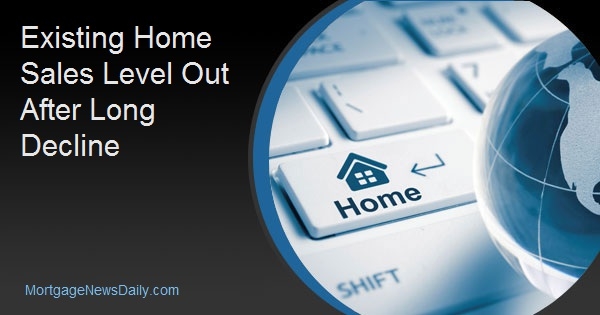It was a disappointment, but at least it wasn't a loss. Existing home sales, which were expected to increase in August after four straight months of declines instead remained unchanged from July. In fact, almost the entire report on August's existing home sales can be summarized by the word, "flat."
Said sales of single-family homes, townhouses, condos, and cooperative apartments were at the seasonally adjusted rate of 5.34 million, identical to the July rate. Sales in July had fallen 1.5 percent below those from a year earlier, and that too was unchanged in the August to August comparisons. Existing home sales were selling at an annual rate of 5.42 million in August of last year.
Econoday said the analysts it polls were expecting at least a modest increase after months of lagging sales analysts. They forecasted results in the range of 5.290 million to 5.460 million with a consensus of 5.360 million.
Sales of both single-family homes and condos didn't sparkle either. Single-family sales were at the same 4.75 million annual rate as in July and condo sales remained at 590,000 units. Single family sales remain below sales a year earlier, by 1.0 percent and condo sales are down 4.8 percent.
Lawrence Yun, NAR chief economist, says the decline in existing home sales appears to have hit a plateau with robust regional sales. "Strong gains in the Northeast and a moderate uptick in the Midwest helped to balance out any losses in the South and West, halting months of downward momentum," he said. "With inventory stabilizing and modestly rising, buyers appear ready to step back into the market."
The median existing-home price for all housing types in August was $264,800, a 4.6 percent gain from the August 2017 median of $253,100. This marks the 78th straight month of year-over-year gains. Single-family homes posted a price increase at the median of 4.9 percent to $267,300. Condo prices reflected a 2.0 percent appreciation at $244,500.
After some minor improvement in June the number of available homes stayed at the same level to which they retreated in July 1.92 million units. This is however up from the 1.87 million homes that were for sales last August. The August inventory is estimated to be a 4.3 month supply at the current sales pace, about the same as in July and slightly better than the 4.1 months' supply a year ago. Properties typically stayed on the market for 29 days in August, up from 27 days in July but down from 30 days a year ago. Fifty-two percent of homes sold in August were on the market for less than a month.
"While inventory continues to show modest year over year gains, it is still far from a healthy level and new home construction is not keeping up to satisfy demand," said Yun. "Homes continue to fly off the shelves with a majority of properties selling within a month, indicating that more inventory - especially moderately priced, entry-level homes - would propel sales."
"Rising interests rates along with high home prices and lack of inventory continues to push entry-level and first time home buyers out of the market," he continued. "Realtors® continue to report that the demand is there - that current renters want to become homeowners - but there simply are not enough properties available in their price range."
First-time buyers were 31 percent of sales in August, down from last month (32 percent) but the same as a year ago. Investors accounted for 13 percent of home sales, the same as in July. Twenty percent of transactions were all cash and distressed sales represented 3 percent, the lowest share since NAR started tracking in in October 2008.
"Realtors® across the country report that their clients waver about the decision to list their home; they are excited by the prospect of receiving many offers, they are concerned that they will not be able to find a new home to purchase," said NAR President Elizabeth Mendenhall. "Unfortunately this fluctuating view is contributing to the short supply of homes. Buyers hoping to find an entry level home in this market should work with a Realtor® and be prepared to move quickly as listings sell quickly."
There was a little more movement in regional sales, however as Yun pointed out, sales in half of the regions offset the rest. Sales in the Northeast bumped up by 7.6 percent in August to an annual rate of 710,000 units which was however down 2.7 percent lower from a year earlier. The median price in the Northeast was $292,800, a 2.6 percent annual increase.
In the Midwest, existing-home sales rose 2.4 percent to an annual rate of 1.28 million, remaining behind the year-ago level by 0.8 percent. The median price in the region rose 3.4 percent to $208,500.
Existing-home sales in the South were at an annual rate of 2.23 million, an 0.4 percent decline from July but up from 2.19 million year-over-year. The median priced home in the South cost $227,900, 3.2 percent more than in August 2017.
Existing-home sales in the West dropped 5.9 percent to an annual rate of 1.12 million and are 7.4 percent below a year ago. The median price rose 4.8 percent to $392,900.







